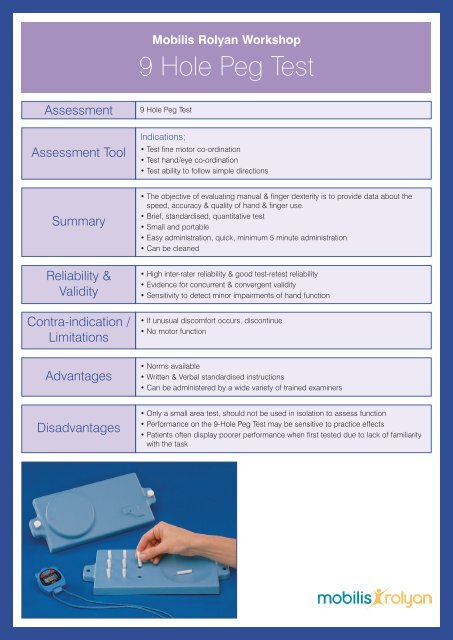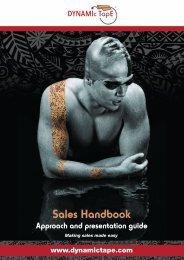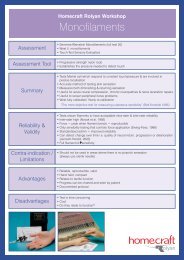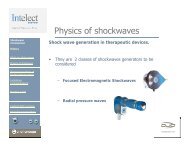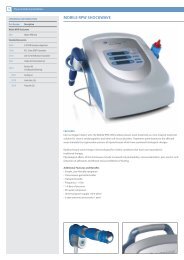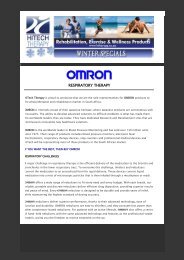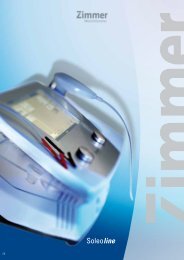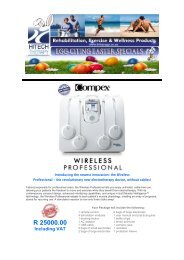9 Hole Peg Test
9 Hole Peg Test
9 Hole Peg Test
You also want an ePaper? Increase the reach of your titles
YUMPU automatically turns print PDFs into web optimized ePapers that Google loves.
Mobilis Rolyan Workshop<br />
9 <strong>Hole</strong> <strong>Peg</strong> <strong>Test</strong><br />
Assessment<br />
Assessment Tool<br />
Summary<br />
Reliability &<br />
Validity<br />
Contra-indication /<br />
Limitations<br />
Advantages<br />
Disadvantages<br />
9 <strong>Hole</strong> <strong>Peg</strong> <strong>Test</strong><br />
Indications;<br />
• <strong>Test</strong> fine motor co-ordination<br />
• <strong>Test</strong> hand/eye co-ordination<br />
• <strong>Test</strong> ability to follow simple directions<br />
• The objective of evaluating manual & finger dexterity is to provide data about the<br />
speed, accuracy & quality of hand & finger use.<br />
• Brief, standardised, quantitative test<br />
• Small and portable<br />
• Easy administration, quick, minimum 5 minute administration<br />
• Can be cleaned<br />
• High inter-rater reliability & good test-retest reliability<br />
• Evidence for concurrent & convergent validity<br />
• Sensitivity to detect minor impairments of hand function<br />
• If unusual discomfort occurs, discontinue<br />
• No motor function<br />
• Norms available<br />
• Written & Verbal standardised instructions<br />
• Can be administered by a wide variety of trained examiners<br />
• Only a small area test, should not be used in isolation to assess function<br />
• Performance on the 9-<strong>Hole</strong> <strong>Peg</strong> <strong>Test</strong> may be sensitive to practice effects<br />
• Patients often display poorer performance when first tested due to lack of familiarity<br />
with the task
Administration<br />
• <strong>Test</strong> dominant hand first<br />
• Position board horizontally with rounded container next to tested hand<br />
• Read following directions to the patient:<br />
• This will be a practice test. Pick up the pegs one at a time using the hand to be<br />
tested only. Place them in the holes until all nine holes are filled. Then remove all of<br />
them one at a time. The pegs can be placed in the holes in any order. This is a<br />
practice test. Are you ready?<br />
• Begin<br />
• If person does not understand instructions demo can be performed<br />
• After patient completes practice test, read the following:<br />
• This will be the actual test. Pick up the pegs one at a time using the hand to be<br />
tested only. Place them in the holes until all nine holes are filled. Then remove all of<br />
them one at a time. The pegs can be placed in the holes in any order.<br />
• Are you ready?<br />
• Begin<br />
• Start stop watch as soon as person touches first peg & stop as last peg hits container<br />
• Reposition unit on opposite side & repeat test<br />
Male Norms<br />
Age Hand Mean SD SE Low High<br />
20-24 R 16.1 1.9 .35 13 22<br />
L 16.8 2.2 .41 13 23<br />
25-29 R 16.7 1.6 .31 14 21<br />
L 17.7 1.6 .31 15 21<br />
30-34 R 17.7 2.5 .48 14 24<br />
L 18.7 2.2 .48 14 24<br />
35-39 R 17.9 2.4 .48 15 26<br />
L 19.4 3.5 .70 14 28<br />
40-44 R 17.7 2.2 .43 14 22<br />
L 18.9 2.0 .39 16 24<br />
45-49 R 18.8 2.3 .43 15 24<br />
L 20.4 2.9 .55 15 27<br />
50-54 R 19.2 1.8 .36 15 22<br />
L 20.7 2.3 .46 16 25<br />
55-59 R 19.2 2.6 .56 14 25<br />
L 21.0 3.2 .70 17 27<br />
60-64 R 20.3 2.6 .54 15 25<br />
L 21.0 2.5 .51 18 27<br />
65-69 R 20.7 2.9 .55 15 29<br />
L 22.9 3.5 .67 18 30<br />
70-74 R 22.0 3.3 .65 17 30<br />
L 23.8 3.9 .77 16 33<br />
75+ R 22.9 4.0 .80 17 35<br />
L 26.4 4.8 .96 19 37<br />
All Male R 19.0 3.2 .18 13 35<br />
Subjects L 20.6 3.9 .22 13 37<br />
Female Norms<br />
Age Hand Mean SD SE Low High<br />
20-24 R 15.8 2.1 .41 12 22<br />
L 17.2 2.4 .47 14 26<br />
25-29 R 15.8 2.2 .43 13 23<br />
L 17.2 2.1 .40 15 25<br />
30-34 R 16.3 1.9 .36 13 20<br />
L 17.8 2.0 .40 15 22<br />
35-39 R 16.4 1.6 .32 14 20<br />
L 17.3 2.0 .40 15 21<br />
40-44 R 16.8 2.1 .37 14 23<br />
L 18.6 2.8 .51 15 24<br />
45-49 R 17.3 2.0 .39 13 23<br />
L 18.4 1.9 .38 16 24<br />
50-54 R 18.0 2.5 .50 14 24<br />
L 20.1 3.0 .60 16 26<br />
55-59 R 17.8 2.6 .52 14 26<br />
L 19.4 2.3 .47 16 24<br />
60-64 R 18.4 2.0 .39 15 22<br />
L 20.6 2.2 .44 17 25<br />
65-69 R 19.5 2.3 .44 16 25<br />
L 21.4 2.7 .51 17 26<br />
70-74 R 20.2 2.7 .51 15 26<br />
L 22.0 2.7 .51 18 27<br />
75+ R 21.5 2.9 .58 17 31<br />
L 24.6 4.3 .85 18 35<br />
All Female R 17.9 2.8 .16 12 31<br />
Subjects L 19.6 3.4 .19 14 35<br />
References:<br />
Jerosch-Herold C. (2005) An Evidence Based Approach to Choosing Outcome Measures: A checklist for the critical appraisal of Validity, Reliability and<br />
Responsiveness Studies. British Journal of Occupational Therapy Aug 2005 68(8): 347-353<br />
McPhee S. (1987) Functional Hand Evaluations: a review. American Journal of Occupational Therapy. 43(3):158-163.<br />
Mathiowetz V Weber K;Kashman N;Volland G (1985) Adult norms for the nine-hole peg test of finger dexterity. Occupational Therapy Journal of Research 5:1:25-<br />
37<br />
Mathiowetz V; Volland G; Kashman N; Weber K. IN: Wade DT (1992). Measurement in neurological rehabilitation. New York: Oxford University Press. Pg.171-171<br />
Simpson C. (2005) 2nd Ed. Hand Assessment: A clinical guide for therapists. Cromwell Press Ltd.<br />
AW00212 Is3


